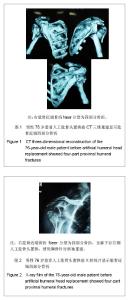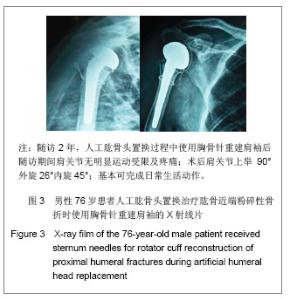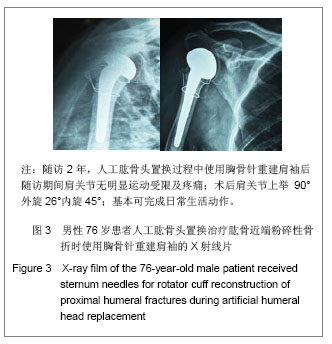Chinese Journal of Tissue Engineering Research ›› 2013, Vol. 17 ›› Issue (22): 4018-4024.doi: 10.3969/j.issn.2095-4344.2013.22.005
Previous Articles Next Articles
Sternum needles for rotator cuff reconstruction of proximal humeral fractures during artificial humeral head replacement
Zhang Chi, Shang Xi-fu, Chen Tao, Hu Fei
- Second Department of Orthopedics, the Affiliated Provincial Hospital of Anhui Medical University, Hefei 230001, Anhui Province, China
-
Online:2013-05-28Published:2013-05-28 -
Contact:Shang Xi-fu, M.D., Professor, Chief physician, Master’s supervisor, Second Department of Orthopedics, the Affiliated Provincial Hospital of Anhui Medical University, Hefei 230001, Anhui Province, China shangxifu@163.com -
About author:Zhang Chi★, Studying for master’s degree, Second Department of Orthopedics, the Affiliated Provincial Hospital of Anhui Medical University, Hefei 230001, Anhui Province, China zhangchi19870306@163.com
CLC Number:
Cite this article
Zhang Chi, Shang Xi-fu, Chen Tao, Hu Fei. Sternum needles for rotator cuff reconstruction of proximal humeral fractures during artificial humeral head replacement[J]. Chinese Journal of Tissue Engineering Research, 2013, 17(22): 4018-4024.
share this article
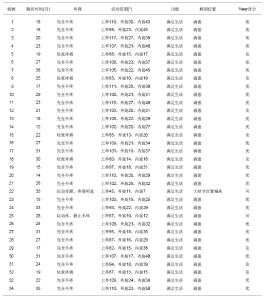
2.1 参与者数量分析 按意向性处理分析,纳入34例人工肱骨头置换过程中使用胸骨针行肱骨近端骨折肩袖重建患者,全部进入结果分析,无脱落。 2.2 随访结果 本组34例患者均获得随访,随访时间1-3年。随访结果:①疼痛:5例轻度疼痛,27例完全不疼,1例肱骨假体留置过长致肩关节上举运动痛、静止不痛,1例肩关节运动受限、疼痛。②运动范围:34例肱骨近端骨折患者术后上举45°-120°,平均(93.00± 6.15)°;外旋0°-28°,平均(23.00±14.12)°;内旋0°-50°,平均(38.50±12.19)°。③功能:34例患者均能完成日常生活动作(如梳头、穿衣、摸背等)。④X射线表现:随访期间假体无松动、脱位,及异位骨化等并发症发生,1 例大结节高于人工肱骨头假体。本组患者中24例为优,8例为良,2例为可。 34例人工肱骨头置换过程中使用胸骨针行肱骨近端骨折肩袖重建患者的随访结果: Follow-up results of the 34 patients with sternum needles for rotator cuff reconstruction of proximal humeral fractures during artificial humeral head replacement:"
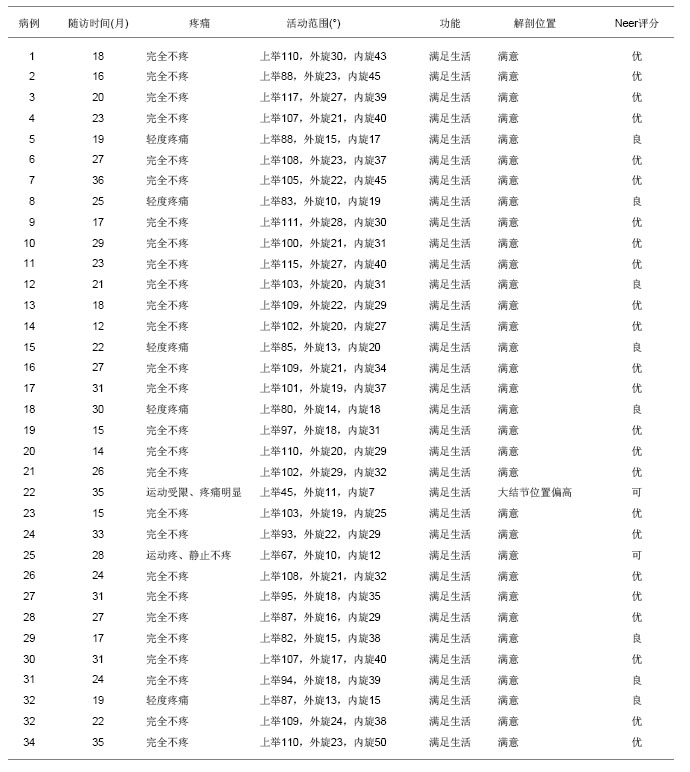
| [1]Wang YC. Beijing: People’s Medical Publishing House. 2004: 756-768.王亦璁.骨与关节损伤[M].北京:人民卫生出版社, 2004:756-768.[2]Jiang C. Zhonghua Waike Zazhi. 2003;41(9):649-653.姜春岩.人工肱骨头置换治疗复杂肱骨近端骨折[J].中华外科杂志, 2003,41(9):649-653.[3]Chen JM, Huang BS, Xiao LJ, et al. Zhonghua Guanjie Waike Zazhi: Dianziban. 2009;3(5):612-616.陈健民,黄炳生,肖立军,等.单纯人工肱骨头置换术治疗胲骨近端粉碎性骨折[J].中华关节外科杂志:电子版,2009,3(5):612-616.[4]Gartsman GM,Roddey TS,Hammerman SM. Shoulder arthroplasty with or without resurfacing of the glenoid in patients who have ostearthritis J Bone Joint Surg Am. 2001; 82(1):26-34.[5]Kontakis G, Koutras C, Tosounidis T, et al. Early management of proximal humeral fractures with hemiarthroplasty: a systematic review. J Bone Joint Surg Br. 2008;90(11): 1407-1413. [6]Neer CS. Displaced proximal humeral fractures: part I. Classification and evaluation. Clin Orthop Relat Res. 2006; 442: 77-82.[7]Zhao CM, Fan WM, Wang Q, et al. Zhongguo Linchuang Jiepouxue Zazhi. 2008;26(5):497-499.赵春明,范卫民,王青,等. 肱骨近端解剖测量在人工肩关节置换中的意义[J]. 中国临床解剖学杂志,2008,26(5):497-499.[8]Rozing PM, Brand R. Rotator cuff repair during shoulder arthroplasty in rheumatoid arthritis. J Arthroplasty. 1998;13(3): 311.[9]Mestdagh H, Petroff E, Maynou C,et al.Effect of the rotator cuff condition on the results of shoulder arthroplasty. Rev Chir Orthop Reparatrice Appar Mot. 1997;83(6):522-530.[10]Qian QR, WU HS, Zhou WJ, et al. Zhongguo Guyuguanjie Sunshang Zazhi. 2007;22(4):277-279.钱齐荣,吴海山,周维江,等.人工肩关节置换术肩袖功能的重建[J].中国骨与关节损伤杂志,2007,22(4):277-279.[11]Heers G, Torchia ME. Shoulder hemi-arthroplasty in proximal humeral fractures. Orthopade. 2001;30(6):386-394. [12]Loebenberg MI,Jones DA,Zuckerman JD.The effect of greater tuberosity placement on active range of motion after hemiarthroplasty for acute fractures of the proximal humerus. Bull Hosp Jt Dis. 2005;62(3-4):90-93.[13]Kralinger F,Schwaiger R,Farrell E,et al. Outcome after primary hemi-arthroplasty for fracture of the head of the humerns. J Bone Joint Surg(Br). 2004;86(2):217-219.[14]Boardman ND 3rd,Cofield RH,Bengtson KA,et al. Rehabilitation after total shoulder arthroplasty. J Arthroplasty. 2001;16(4):483-486.[15]Neer CS,Watson KC,Stanton FJ. Recent experience in total shoulder replacement. J Bone Joint Surg Am. 1982;64(3): 319-337.[16]Guan WY, Kong XY. Zhonghua Huli Zazhi. 2008;43(4): 310.关文也,孔祥燕,肱骨头假体置换术治疗肱骨近端骨折的康复锻炼[J].中华护理杂志,2008, 43(4): 310. |
| [1] | Chen Ziyang, Pu Rui, Deng Shuang, Yuan Lingyan. Regulatory effect of exosomes on exercise-mediated insulin resistance diseases [J]. Chinese Journal of Tissue Engineering Research, 2021, 25(25): 4089-4094. |
| [2] | Jiang Xiaoyan, Zhu Haifei, Lin Haiqi, Lin Wentao. Cold therapy promotes self-limited recovery of delayed-onset muscle soreness [J]. Chinese Journal of Tissue Engineering Research, 2021, 25(23): 3609-3613. |
| [3] | Xie Jingshu, Zhang Xianglin, Liu Jinlei, Wen Jing. Application of High Resolution reconstruction algorithm in precision CT scans of the middle and inner ears [J]. Chinese Journal of Tissue Engineering Research, 2021, 25(23): 3614-3618. |
| [4] | Liu Jinwei, Chen Yunzhen, Wan Chunyou. Changes of osteogenic growth factors in the broken end of bone nonunion under stress [J]. Chinese Journal of Tissue Engineering Research, 2021, 25(23): 3619-3624. |
| [5] | Luo Anyu, Liu Hanlin, Xie Xiaofei, Huang Chen. Effect of antioxidant mixture on structural degeneration of an osteoarthritis rat model [J]. Chinese Journal of Tissue Engineering Research, 2021, 25(23): 3625-3629. |
| [6] | Zhou Wu, Wang Binping, Wang Yawen, Cheng Yanan, Huang Xieshan. Transforming growth factor beta combined with bone morphogenetic protein-2 induces the proliferation and differentiation of mouse MC3T3-E1 cells [J]. Chinese Journal of Tissue Engineering Research, 2021, 25(23): 3630-3635. |
| [7] | Gao Kun, Chen Dayu, Zhang Yong, Liu Weidong, Sun Shufen, Lai Wenqiang, Ma Dujun, Wu Yihong, Lin Zhanpeng, Jiang Yinglu, Yu Weiji. Achyranthes bidentata alcohol extract inhibits extracellular matrix degradation of the cartilage by regulating synovial fibroblast exosomes [J]. Chinese Journal of Tissue Engineering Research, 2021, 25(23): 3636-3640. |
| [8] | Liang Meifu, Qu Shuhua. Optimal power load forecasting of the skeletal muscle based on back propagation neural network [J]. Chinese Journal of Tissue Engineering Research, 2021, 25(23): 3641-3647. |
| [9] | Bai Shengchao, Gao Yang, Wang Bo, Li Junping, Wang Ruiyuan. Dynamic changes of mitochondrial function of the skeletal muscle after acupuncture intervention in rats with heavy load exercise-induced injury [J]. Chinese Journal of Tissue Engineering Research, 2021, 25(23): 3648-3653. |
| [10] | Yang Caihui, Liu Qicheng, Dong Ming, Wang Lina, Zuo Meina, Lu Ying, Niu Weidong. Serine/threonine protein kinases can promote bone destruction in mouse models of chronic periapical periodontitis [J]. Chinese Journal of Tissue Engineering Research, 2021, 25(23): 3654-3659. |
| [11] | Fan Junchao, Chen Yong, Song Junjie. Sevoflurance combined with xenon pretreatment protects against spinal cord ischemia-reperfusion injury in a rat model [J]. Chinese Journal of Tissue Engineering Research, 2021, 25(23): 3660-3665. |
| [12] | Zuo Zhenkui, Han Jiarui, Ji Shuling, He Lulu. Pretreatment with ginkgo biloba extract 50 alleviates radiation-induced acute intestinal injury in mice [J]. Chinese Journal of Tissue Engineering Research, 2021, 25(23): 3666-3671. |
| [13] | Zhang Liang, Ma Xiaoyan, Wang Jiahong. Regulatory mechanism of Shenshuai Yin on cell apoptosis in the kidney of chronic renal failure rats [J]. Chinese Journal of Tissue Engineering Research, 2021, 25(23): 3672-3677. |
| [14] | Cheng Yanan, Wu Yucong, Mao Qiuhua, Chen Ling, Lu Liying, Xu Pu. Restoration effect and stability of resin infiltration combined with bioactive glass on demineralized tooth enamel [J]. Chinese Journal of Tissue Engineering Research, 2021, 25(22): 3522-3526. |
| [15] | Bi Qingwei, Liu Chengpu, Li Yan, Zhao Wenwen, Han Mei. Structure analysis of platelet-rich fibrin derived from two centrifugation procedures [J]. Chinese Journal of Tissue Engineering Research, 2021, 25(22): 3534-3539. |
| Viewed | ||||||
|
Full text |
|
|||||
|
Abstract |
|
|||||
